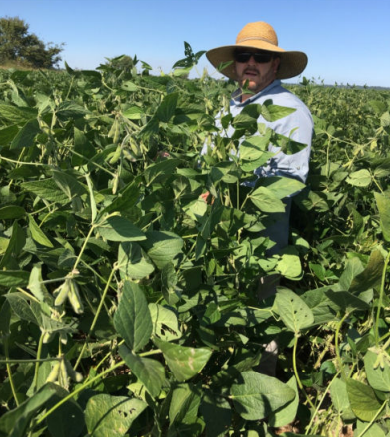Big Buck 6™
Big Buck 6 is the premium non-GMO forage soybean. It is easy to establish, has large, high protein leaves, is very tall, and has excellent forage yield. It can be grown naturally without the use of herbicides. This variety contains no genes for glyphosate or Roundup Tolerance.

Big Buck is conventionally bred and capable of reaching heights over six feet. Among the available non-gmo forage varieties, this variety has higher tonnage as shown in several state university tests. You can follow conventional soybean herbicide treatments to easily eliminate weeds from the plots.
Fertilizer
- Always store seed in a low humidity areas, below 90°F. The optimum pH for soybeans is between 6.0 and 7.0; 6.5 is ideal.
- Inoculate soybeans with Bradyrhizobium japonicum if the soil has either high or low pH, has been water-logged or extremely cold, or has no recent soybean production. Inoculant can also reduce your costs. Nitrogen is not needed on decent soil if the soybeans are inoculated. Starter N is fine. We recommend inoculant be applied to the seed just prior to planting. Add the inoculant to the seed hopper and stir gently, do not add moisture (check with inoculant label).
- For best results, fertilize according to your farm’s soil test as analyzed by your State Extension Service. If you don’t have a soil test, use inoculant and 0-40-70 (units). Soybeans remove a minimum of 40 lbs of Phosphorous and 70 lbs of Potassium. For maximum deer antler and body weight production, deer biologists recommend 0-70-120 (units).
Planting Time, Depth, Spacings
- In general, most northern food plotters can plant in late May or early June. Southern food plots can usually be planted in late April to early May. Check with your local extension service for optimum dates. This is usually after your last spring frost when the soil temperature at a one inch planting depth is above 65°F, but no greater than 90°F. Soybeans have a different kind of emergence, so it is usually best to plant after a rain. Rain can cause surface soil compaction and crusting which prevents plant establishment.
- The recommended planting depth is 3/4 to 1 inch into a moist soil. Do not plant in a dry soil, or in muddy conditions. Put seeds 1/4 inch below soil moisture line, but no deeper than 1.5 inches. If you do not see emergence in 7 days, check the seeds for sprouting. When broadcasting, increase your seeding rate to 75 lbs per acre since not every seed will have proper seed to soil contact.
Seed size will vary, so use a minimum of one bag to the acre. If planting in less than optimal conditions or heavy deer densities, use a higher plant population and a narrower row, up to 15 inches in width.
Herbicides
- You can apply Valor or Prowl for preplant at the labeled rate; it must be rained in within 48 hours. Post-emerge, use Flexstar and Clethodim at the labeled rate and timing. Flexstar requires the first trifoliate to have emerged. Always follow pesticide labels.
Establishment
Plants grow slower in cooler spring temperatures, so use deer deterrents for the first 4-8 weeks, especially in areas of heavy deer pressure or in cooler temperatures. Make sure your crops have good drainage. Soybean plant growth and nitrogen fixation can be lost when water stands on an area for 3 or more days. Avoid flood prone areas.
*Data compiled from multiple states and sources including extension and university data.
